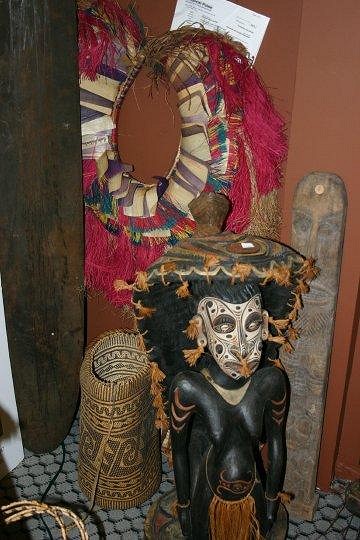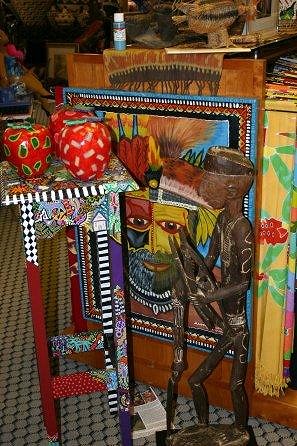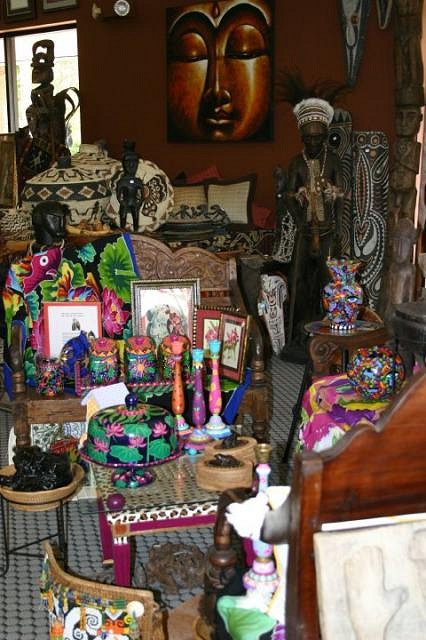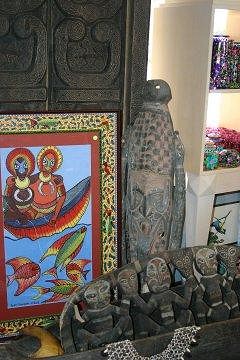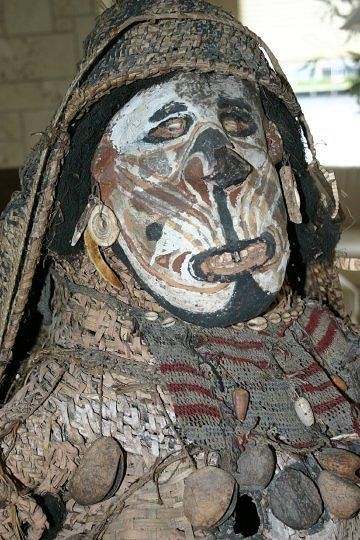Tiki Central / Collecting Tiki / Oceania, Etc: vendor of South Seas Art
Post #157778 by I dream of tiki on Tue, May 10, 2005 6:35 PM
|
IDOT

I dream of tiki
Posted
posted
on
Tue, May 10, 2005 6:35 PM
More Colorful components of the collection
In very front, statue from palembei: bride wearing bridal cap again
"Few masks are worn directly over the face, which explains the lack of holes for eyes. Some are fastened onto a large cone-shaped wicker framework for a dance costume called a tumbuan. Raffia is knotted into the bottom hoop for skirting and flowers, fruit and leaves added on for color and power at the time of the ceremony. Other masks are made only for display, most often in the men's Haus, to attract powerful and useful spirits. The individual elements of the masks are complex, they often refer directly or indirectly to ancestor or clan spirits and totems such as pig, cassowary (muruk), crocodile (pukpuk), eagle (taragau), or a water and bush bird (saun). There are many different types of masks for different purposes. Short nosed wickerwork masks, such as this one, represent females but they are rarer. The male masks-costumes are worn with skirts to the knee, while the female skirts stop at the ankle. They represent the face of a supernatural being, a totemic clan ancestor, and are affixed, for the initiation dance of boys, to the woven body shroud called "tumbuan" (which in turn represents a spirit from the era of the creation). Any mask used in such ceremonies was closely associated with the supernatural because initiation involved, amongst other things, communion with the clan spirits. The masks represent the spirits of totemic names. Names are very sacred in PNG. No one actually says anyone's real name, including their own, for fear of drawing the attention of bad spirits or sorcerers. During initiations, the elder who wears the mask-costume becomes a spirit teacher who may say the important totemic names without evoking personal risk. He tells and calls out names for use in magic, for healing and for other spiritual uses. These names number in the thousands and only powerful men have this knowledge. Missionaries gave women catholic names but their real name remains a secret they will not divulge: they refuse to tell it to anyone in their own language as that would give other people power and control over them. If a village or clan has a lot of bad luck, the whole group may change their names and buy the rights to use masks from another clan in a different village in an attempt to fool the bad spirits or sorcerers. The resulting masks usually display characteristics of both groups. Each Sepik River village otherwise is independent and has a distinctive style of art. No two masks can ever be exactly the same, even in the same village. Each is crafted by a different artist, representing a different ancestor or spirit, reflects that artist individual flair and is therefore unique. As a matter of fact, copying is forbidden and sentenced by local law unless there is a formal agreement between the parties involved. Masks and Statues of Papua New Guinea’s cultures serve a variety of spiritual, cultural and decorative purposes. Most of the masks found in PNG are from the Sepik region, where the production and use of masks is an important part of traditional culture. Ancestral masks represent deceased clan ancestors, totemic creatures that assist the tribe by interceding on a high plane to provide food, prevent and cure illness, while spirit masks embody tribal spirits who inhabit the surrounding jungle, & may come to the help of the tribe to counterattack sorcery spells meant to arm them. Ancestral and spirit masks are not designed to be "worn" but are hung in men's houses, spirit houses and other locations of importance. Gable masks (usually woven from cane) are mounted on house gables to protect the occupants from the feared marauding spirits. It is interesting to note that if a mask or any other object, is carved with gnashing teeth or a protruding tongue it is not intended so much as an erotic object but meant to ward off evil spirits." [ Edited by: I dream of tiki 2009-02-20 23:17 ] |

